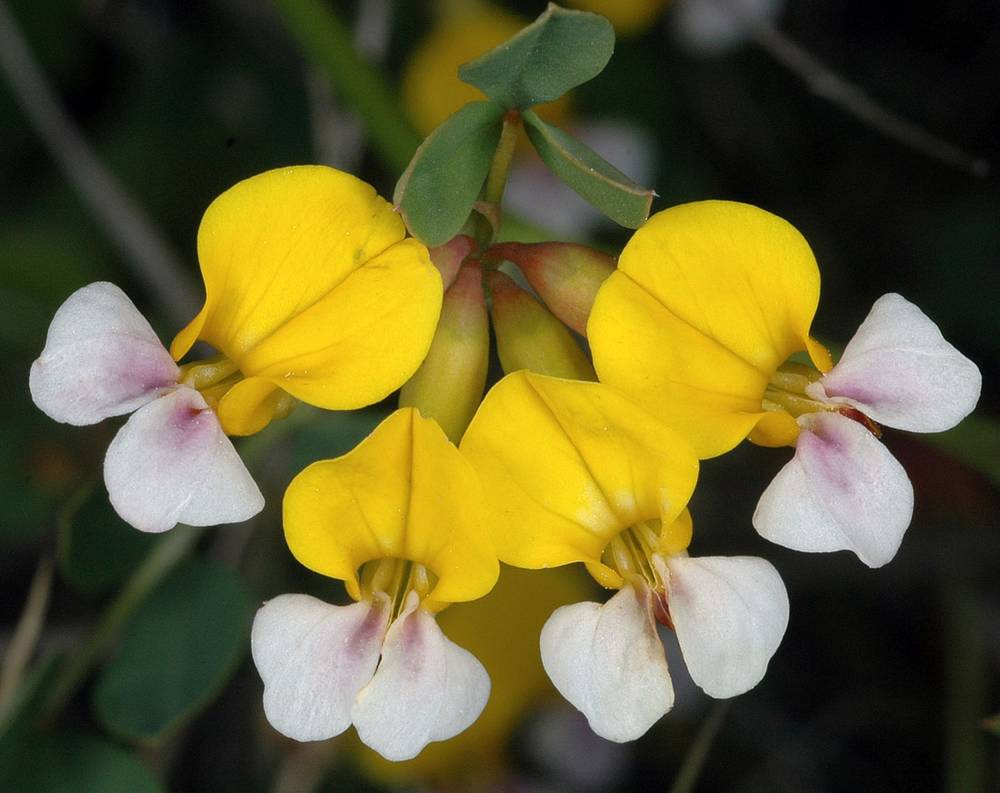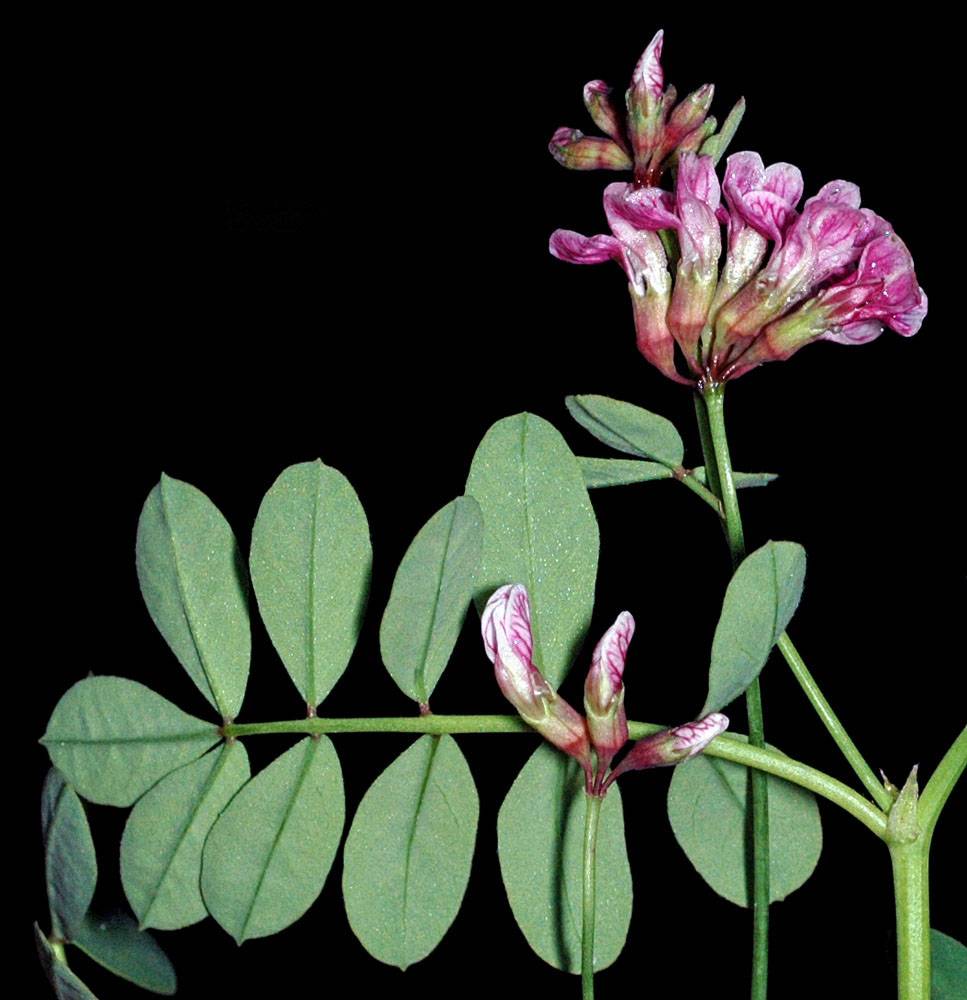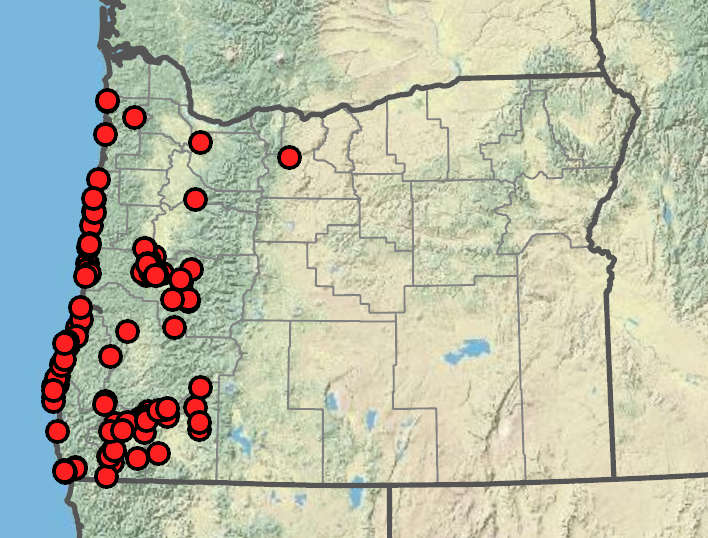Hosackia gracilis
Hosackia rosea
seaside lotus
rosy bird's-foot trefoil
1–20+, prostrate or decumbent to ascending; slender, sometimes sparsely branched, distally usually with scattered or numerous closely appressed, flattened trichomes.
1–10+, inclined or spreading to erect; simple or sparsely branched, glabrous throughout or sparsely puberulent or strigillose distally.
1–6 cm;
leaflets 3–7, elliptic or oblanceolate to obovate, 3.5–19 × 1.5–9 mm;
margins eciliate or rarely sparsely ciliate;
tips obtuse to emarginate;
surfaces glabrous;
petiolules 0.3–1 mm.
3–15 cm;
leaflets 7–17, elliptic or oblong to obovate or oblanceolate, 8–40 × 9–18 mm;
margins usually ciliate;
tips obtuse or rounded to truncate or retuse;
surfaces moderately strigillose; less so adaxially, glabrate to glabrous with age;
petiolules 0.5–1.5 mm.
2–5(6)-flowered, with flowers ± on one side;
pedicels 0.5–1.5 mm.
5–15-flowered, with flowers usually facing in same direction;
pedicels 2–5 mm.
spreading to ascending or erect, 1.5–8 cm, often much > subtending leaf, elongating in fruit, often bearing a few scattered or sometimes copious closely appressed, flattened trichomes;
bracts directly subtending umbel; leaf-like, 1–3(5)-foliolate.
mostly inclined to erect, 3.5–13(15) cm, often ? subtending leaf; little elongating in fruit, strigillose to glabrate;
bracts usually well separated proximally from umbels, usually somewhat leaf-like, 1–5(7)-foliolate, occasionally scale-like, inconspicuous, rarely absent.
10–14(15) mm;
calyces 4.5–6.5 mm, green, often reddish or with reddish highlights, glabrous;
tubes obconic-cylindric, 2.5–4 mm;
lobes subulate to narrowly triangular, 1.5–2.5 mm, sparsely ciliolate or eciliolate; posterior pair of lobes and anterior 3 dissimilar in size; shape; and spacing;
corollas broad; showy;
claws conspicuously > calyx tubes;
banners large and spreading, yellow to sometimes yellow-orange or red-orange;
wings spreading widely, pale pink to lavender or deep red-violet; inner margins sub-approximate to commonly overlapping;
keels proximally yellow;
tips purple; ~1.5–2 mm < wings.
slightly or not nodding, 9–13 mm;
calyces 4–6 mm, green or suffused with red or purple, glabrous;
tubes cylindric, 3.5–4 mm;
lobes triangular to triangular-subulate, 0.5–2 mm, ciliolate;
corollas broad; showy;
claws > calyx tubes;
banners large, spreading widely, white to rose or red-purple, generally becoming darker, often purple especially along veins;
margins slightly inflexed;
wings widely spreading laterally, colored similar to banner or only veins pinkish; inner margins approximate or overlapping;
keels ~2.5 mm < wings, distally pink or purple.
inclined to declined, linear, 20–40 × 1.5–2.5(3) mm, brown, glabrous.
mostly declined to inclined; ± linear, 20–43 × 3–4 mm; reddish brown, glabrous.
usually 10–14, subreniform, nearly round in outline, 1–1.5 mm; olive to brown.
4–10, oblong, 2–3.5 mm; olive or reddish brown to nearly black.
narrow, deltoid or ovate to lanceolate, 2–6 × 1–3 mm; ± symmetric, scarious;
margins entire or occasionally toothed;
tips acute or acuminate, sometimes bifid.
narrow, triangular or ovate-lanceolate to lanceolate, 3–7 × 1.5–3 mm; ± symmetric, scarious;
margins entire or occasionally toothed or lobed;
tips usually acute to acuminate.
=14.
Hosackia gracilis
Hosackia rosea
Coastal bluffs and dunes, bogs, grasslands, grassy glades. Flowering Apr–Aug. 0–700 m. Est, Sisk, WV. CA, WA; north to British Columbia. Native.
Hosackia gracilis is primarily a coastal species that is most similar to the inland species, H. pinnata. Plants from a few inland populations, especially in Lane County, seem to be somewhat intermediate and may be difficult to place based on corolla color patterns alone. This treatment emphasizes the nature of the peduncle bract in determining the taxonomic placement of questionable material of these two species.
Coastal areas, Douglas-fir forests, logged areas, roadsides. Flowering Apr–Aug. 0–1000 m. Casc, CR, Est, Sisk, WV. CA, WA. Native.
Robust plants of H. rosea may approach the stature of H. crassifolia var. crassifolia. As a result, vegetative material of the two species could be rather easily confused. However, the showy flowers of H. rosea with heavily veined, widely spreading petals, contrast sharply with the inconspicuously veined, narrow, inflexed petals of H. crassifolia var. crassifolia.
Gerald Carr
Gerald Carr
- Local floras:
BC,
CA,
OR,
WA
- Local Web sites:
CalFlora,
CalPhotos,
Flora NW,
PNW Herbaria
WildflowerSearch
iNaturalist (observations)
USDA Plants Database
- LBJ Wildflower Center
- SEINet
- Plants of the World Online
- Encyclopedia of Life
- Wikipedia
- Google Image Search
- Local floras:
CA,
OR,
WA
- Local Web sites:
CalFlora,
CalPhotos,
Flora NW,
PNW Herbaria
WildflowerSearch
iNaturalist (observations)
USDA Plants Database
- LBJ Wildflower Center
- SEINet
- Plants of the World Online
- Encyclopedia of Life
- Wikipedia
- Google Image Search





